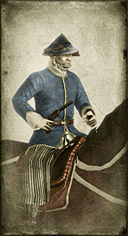
Basic Unit Statistics (can be modified by difficulty level, arts, skills, traits and retainers)
| Recruitment Cost | 1000 | |
| Upkeep Cost | 90 | |
| Melee Attack | 10 | 28% |
| Charge Bonus | 8 | 16% |
| Bonus vs Cavalry | 0 | 0% |
| Range | 70 | 10% |
| Accuracy | 15 | 15% |
| Reloading Skill | 30 | 30% |
| Ammunition | 12 | 15% |
| Melee Defence | 3 | 8% |
| Armour | 2 | 13% |
| Morale | 6 | 12% |
Strengths & Weaknesses
- Average accuracy and very fast reload rate.
- Short range.
- Very fast moving.
- Weak in melee.
- Weak against missile attacks and spear units.
- Good morale.
Description
Revolver cavalry can unleash a tremendous fusilade into the enemy, then gallop away.
These pistol-armed cavalrymen can move quickly across the battlefield to harass enemy flanks, and keep enemy cavalry at bay. The revolvers they carry give them a good deal of short-ranged, rapid firepower, but they are vulnerable in melee. A good general also makes sure that they are not left exposed to artillery fire or massed gun fire from long ranged units. They do, however, have good morale and will break only rarely. A late-19th Century revolver was a single action gun: the user had to pull back the hammer to revolve the cylinder and cock the weapon before squeezing the trigger. Double-action revolvers do everything for each trigger pull. The arrival of brass cartridges with bullet, gunpowder and primer cap in one had made revolvers a good deal safer for the user. Percussion cap revolvers did sometimes explode, causing terrible injuries to the unlucky shooter. Many European governments expected officers to purchase their own side arms, and only insisted that the guns used government-issue ammunition. This resulted in a wide range of "service" revolvers being made and carried into action. Quality and workmanship varied according to the private income of the officer doing the buying. During the American Civil War the practice of carrying many pistols into action had been rediscovered, as this allowed a unit of (usually irregular) troops to lay down a horrendous amount of fire before withdrawing to reload. Almost any gun available would be pressed into use.